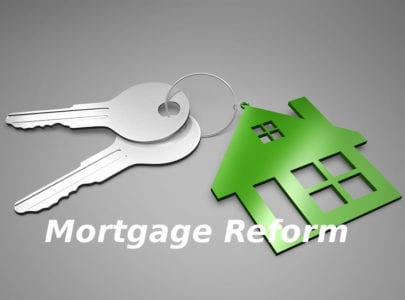 Mortgage Reform and Anti-Predatory Lending Act, amendment to the Truth in Lending Act (TILA), was brought about as a reaction to the lending practices that had lead to the burst of the real estate bubble in 2008. Many mortgages prior to the burst of the real estate bubble included clauses that were unfavorable to those who had borrowed the money. Some such clauses made it impossible to pay off mortgages where the value of the property dropped below the amount of the loan. Mortgage Reform and Anti-Predatory Lending Act established a duty of care, set minimum standards, established limits on high cost mortgages, and established the Office of Housing Counseling, among other things.
Mortgage Reform and Anti-Predatory Lending Act, amendment to the Truth in Lending Act (TILA), was brought about as a reaction to the lending practices that had lead to the burst of the real estate bubble in 2008. Many mortgages prior to the burst of the real estate bubble included clauses that were unfavorable to those who had borrowed the money. Some such clauses made it impossible to pay off mortgages where the value of the property dropped below the amount of the loan. Mortgage Reform and Anti-Predatory Lending Act established a duty of care, set minimum standards, established limits on high cost mortgages, and established the Office of Housing Counseling, among other things.
Under the Mortgage Reform and Anti-Predatory Lending Act, all mortgage originators have a duty of care. Mortgage originators now must comply with regulations set forth by the Federal Reserve Board, to be able to comply they are required to be qualified, registered and licensed – as needed. To ensure that mortgage originators no longer steer borrowers towards loans they cannot hope to repay, mortgage originators are no longer allowed a percentage of the loan amount as compensation. Additionally, the Federal Reserve Board was given further authority over unfair and predatory loan terms.
The minimum standards set forth by this act included loan requirements and addressed certain types of prepayment penalties. Mortgage originators must ensure that the borrower can repay the loan. This is done by evaluating several key factors including income (current and expected future income), credit history, and other factors. If there is a violation of the minimum standards, the borrower can use it to recoup damages.Additionally, certain disclosures must be provided to the borrowers for home mortgages.
Mortgages are deemed “high-cost” if they exceed prime lending annual percentage rate by more than 6.5 percentage points on the primary mortgage. Secondary and tertiary mortgages are deemed “high-cost” if their annual percentage rate exceeds prime by 8.5 percentage points.Also, since balloon payments rapidly increase cost of such loans, they are prohibited under the Mortgage Reform and Anti-Predatory Lending Act.
Creditors are required to establish an account to pay the property taxes, insurances and other necessary fees. Consumers can waive this, but they must receive certain disclosures outlining their responsibilities from the creditor. As an extension of this, mortgage loan servicers are governed by certain rules when it comes to obtaining insurance policies on the property without having a reasonable belief that the consumer has not properly maintained property insurance. Likewise, loan servicers must comply with other obligations listed in the Mortgage Reform and Anti-Predatory Lending Act, including responding to valid written requests without fees, prompt response to requests regarding errors in the allocation of payments, or failing to respond to requests regarding loan owners within 10 days.
Before extending high-risk mortgage to a borrower, the lender must obtain an appraisal at the lender’s expense, without exerting undue influence on the appraiser doing the appraisal. Additionally, in order to protect current and future tenants, there is a program that ensures that the property owner has the money to keep up the property, as well as pay financing, and a way to responsibly transfer property to a new owner.
The Mortgage Reform and Anti-Predatory Lending Act reformed the practices of the mortgages lenders and included reforms of Federal National Mortgage Association (“Fannie Mae”) and the Federal Home Loan Mortgage Corporation (“Freddie Mac”). It also set up mandatory disclosures that mortgage lenders are required to provide. Additionally, it prohibits predatory lending practices that were rampant before the real estate bubble burst. Furthermore, it established provisions for loan modifications that help borrowers, in certain situations, make changes to loans that are out of their ability to repay.
Image credit: 472301

